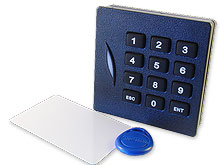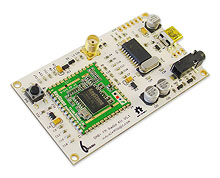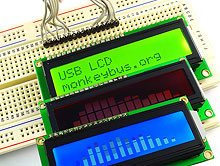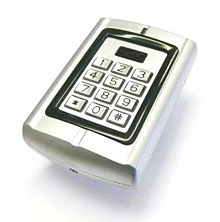RFID Wiegand Protocol Development Kit for Arduino and PIC

The Wiegand interface is a de facto standard commonly used to connect a card reader or keypad to an electronic entry system. Wiegand interface has the ability to transmit signal over long distance with a simple 3 wires connection. This kit comes with open source schematic, PCB and C source code. It is all ready to go and easy to be modified for specific usage. Wiegand data from a card/tag or keypad buttons will be translated into host computer’s key. Any application expecting a keyboard will be able to receive the wiegand data.
Add a commentDAB DAB+ FM Digital Radio Development Board
 Open source DAB+ FM Digital Radio Development Board based on the Keystone T1_L4A_8290C DAB+/FM module and a Microchip PIC18F14K40 microcontroller. This board provides a platform for developing and evaluating DAB+ and FM receiver. The Microchip PIC18F14K50 emulates a USB virtual serial port for the T1_L4A_8290C module to communicate with the host PC. The sample code provided in this Development Board for communicating with the board is based on serial communication.
Open source DAB+ FM Digital Radio Development Board based on the Keystone T1_L4A_8290C DAB+/FM module and a Microchip PIC18F14K40 microcontroller. This board provides a platform for developing and evaluating DAB+ and FM receiver. The Microchip PIC18F14K50 emulates a USB virtual serial port for the T1_L4A_8290C module to communicate with the host PC. The sample code provided in this Development Board for communicating with the board is based on serial communication.
USB Serial to HD44780 LCD
 HD44780 based character LCD is a de facto industry standard LCD that is used in many designs such as clocks, robots and microcontroller boards. It is readily available from most electronic stores and EBay. Although this LCD is relatively easy to use, however interfacing with this LCD normally requires 6-10 IO pins for 4 bit and 8 bit mode respectively. With most PC no longer built with a parallel port, interfacing with this LCD requires a USB / Serial to LCD interface.
HD44780 based character LCD is a de facto industry standard LCD that is used in many designs such as clocks, robots and microcontroller boards. It is readily available from most electronic stores and EBay. Although this LCD is relatively easy to use, however interfacing with this LCD normally requires 6-10 IO pins for 4 bit and 8 bit mode respectively. With most PC no longer built with a parallel port, interfacing with this LCD requires a USB / Serial to LCD interface.
Wiegand Converter

Access control using a numeric keyboard, radio frequency identification (RFID) or combination of both are widely used in the security and access control industry. These types of devices are affordable, robust and simple to install. The RFID itself comes in various shape and sizes containing two sets of information combined to create a unique credential; the facility code of the card and the card ID. This tutorial shows how to use the MonkeyBUS to interpret signals from RFID readers and determine RFID’s facility code and card ID whilst exploring several important aspects of the PIC18F14K50 microcontroller.
Add a comment

